19 Adding Interactivity to your Pressbook with H5P and Hypothesis
Chapter Purpose
This chapter provides details on the H5P option in Pressbooks that makes the content more interactive for readers. (You may have noticed that this book has used various kinds of H5P tools as examples throughout its chapters.)
What is H5P?
H5P is a popular plugin used to create exciting, interactive content on the web. In Pressbooks, it’s mostly used to create interactive quizzes and other activities in open textbooks and other open educational resources.
There are many different types of content enabled by H5P. You’ve already seen a few in action throughout earlier chapters in this book. You can view examples of them and detailed instructions for creating different types on the H5P website (Note: they offer different installation and embedding options, but that’s all taken care of by Pressbooks – you just need to think of the exciting things you can create!)
You can also check out The H5P Pressbooks Kitchen created by BC Campus! This contains many examples and support information, as well as community engagement regarding H5P.
Activating H5P
Before getting started, your first need to activate the H5P plugin on your book. This can be done under “Plugins” on the left menu.
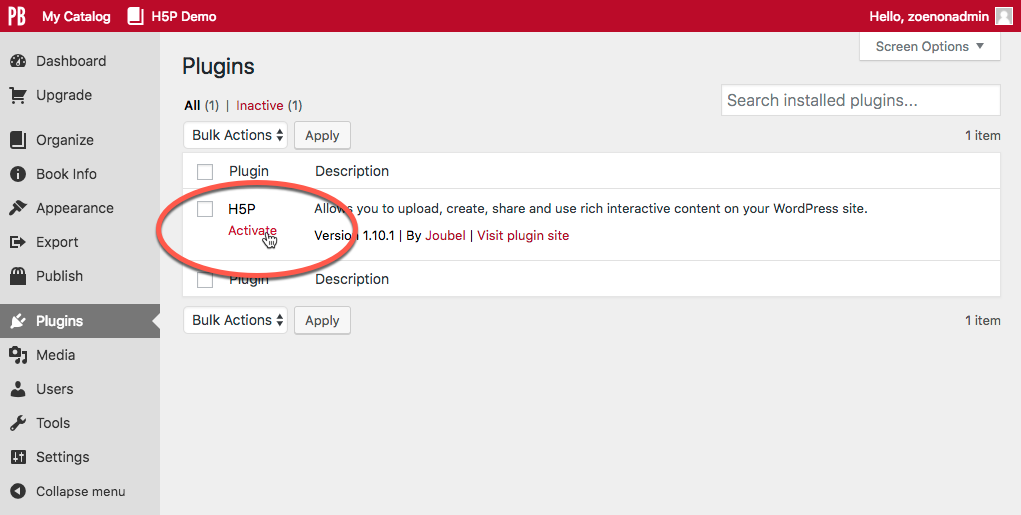
Adding H5P activities
Once the plugin is active, follow these steps to add an H5P element to your book:
- Navigate to the H5P Content menu and select “Add New.”
- Enter a title.
- Select content type from the dropdown menu.
- Install the content type by clicking on “Get” and following the steps indicated (if necessary).
- Enter the information for your quiz/activity etc.
- Click on “Create” when you’re done!
Now that you’ve created your element, you can add it to your chapter. To do so:
- Copy the shortcode displayed in the top right of the screen.
- Navigate to the chapter where you would like add the element.
- Paste the shortcode into place (you can do this in the visual editor, no need to switch to text).
- Save your chapter.
- View the web version to see the element in action.
- Export other desired formats to see the fallback message.
You can also add an H5P element that you had previously created by placing your cursor where you want it to appear in the chapter and clicking Add H5P above your content tools.
See the H5P Interactive Content chapter in the Pressbooks User Guide for more information, including an example of how to create a simple multiple choice question.
Prefer to watch and learn? Check out this video tutorial:
Enable annotation in the webbook version of your project using Hypothesis
Hypothesis is a powerful web annotation tool that many users deploy to enable collaboration between authors and editors, personal note taking and annotation, engagement with readers, or use as a teaching tool with students. This section will cover:
- What is Hypothesis?
- How to enable Hypothesis on your webbook
- How to include and exclude specific chapters or sections from Hypothesis
What is Hypothesis?
Hypothesis is a simple web annotation tool that allows readers to highlight and annotate webpages, enabling deeper engagement with content. While the tool is available as a browser extension that can be used on any webpage, Pressbooks allows you to build its capabilities into the pages of your webbook itself, meaning readers can read and create annotations without installing the extension (so long as they have a Hypothesis account) and public comments will be visible to anyone who comes to your book.
Once Hypothesis is enabled on your webbook (see below), any reader coming to the book will see the Hypothesis toolbar on the right, either open or minimized depending on your settings.
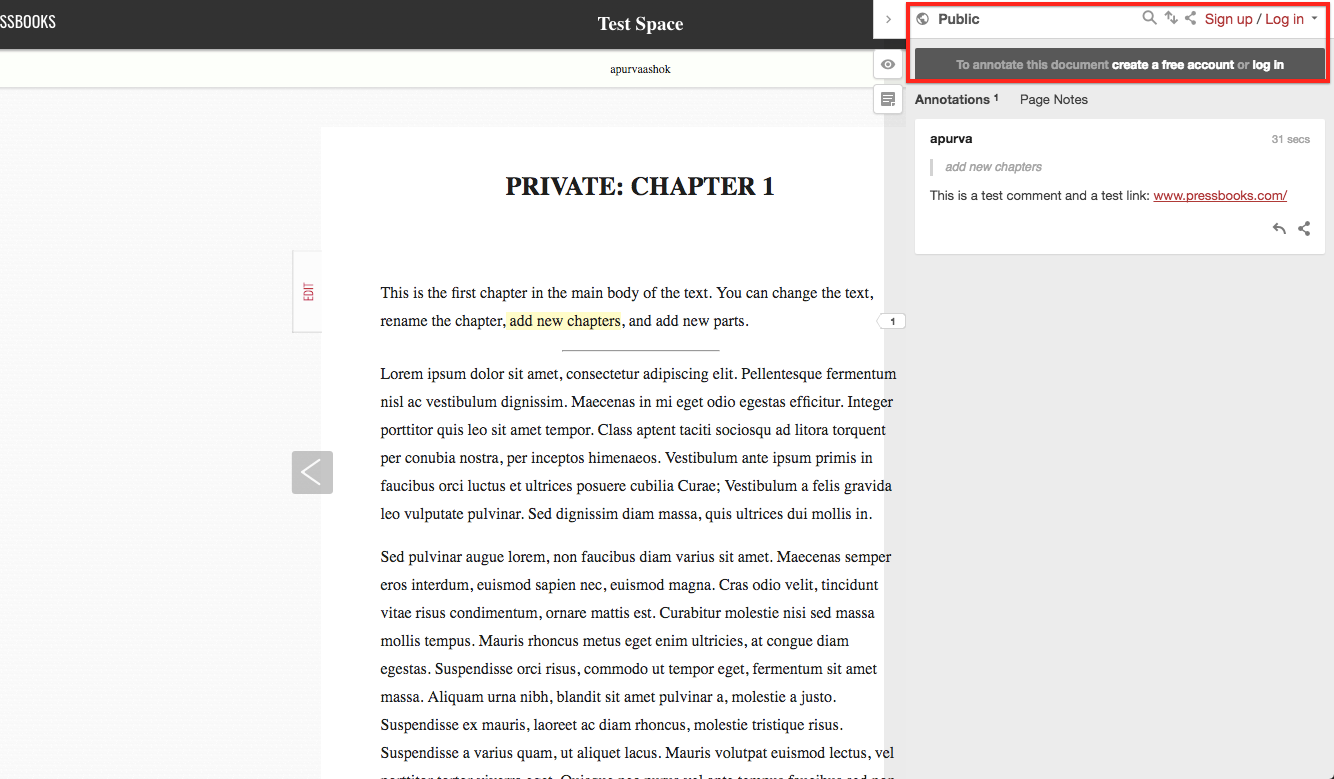
With this toolbar open, the reader will see any public annotations and can create or log into their account. Once logged in, they can select any section of text and a small icon will pop up that lets them either highlight the passage (which will remain private) or add an annotation. Annotations can be edited, deleted, replied to or shared using the icons at the bottom of the annotation section.
These annotations can also be public, private to a reader or in a private group, and the user can toggle between these options at the very top of the toolbar (the default is “Public”). You can read more about creating groups and annotating in groups on the Hypothesis website.
NOTE: If you have your book set to “Private,” you don’t need to create a group to keep your annotations and replies hidden from public view. The Pressbooks privacy setting means that no one can access the book, and as such they can’t see any of the Hypothesis activity on it by default.
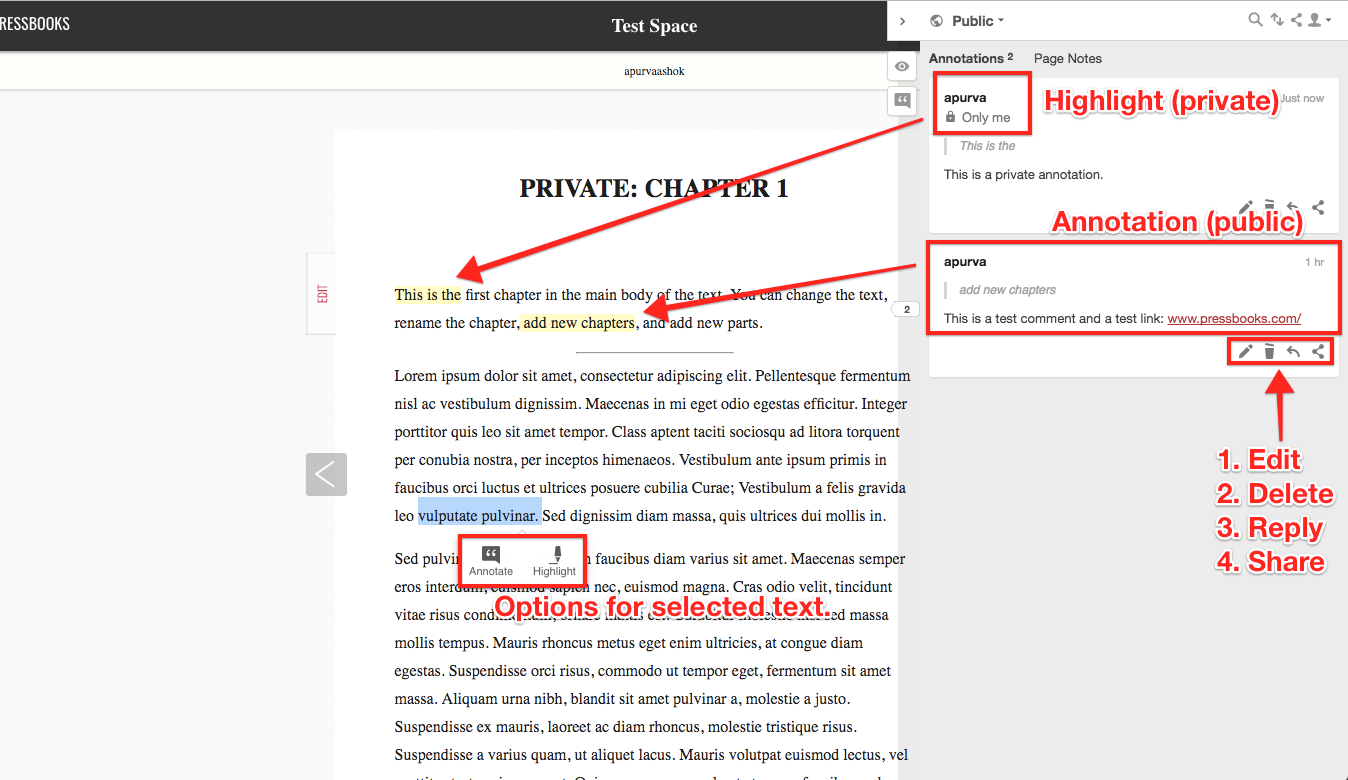
Enabling Hypothesis in a Pressbooks book
By default, Hypothesis will not appear on any pages of your webbook. To enable it, follow these steps:
- Go to “Settings” -> “Hypothesis” in your book
- Select your default behaviors for:
- Displaying highlights
- Displaying the sidebar (you can make it open by default if you wish)
- Enabling annotations on PDFs stored in your media library (NOTE: we discourage the use of your media library for this kind of storage)
- Select the parts of your book on which to allow Hypothesis annotations.
- Save your changes.
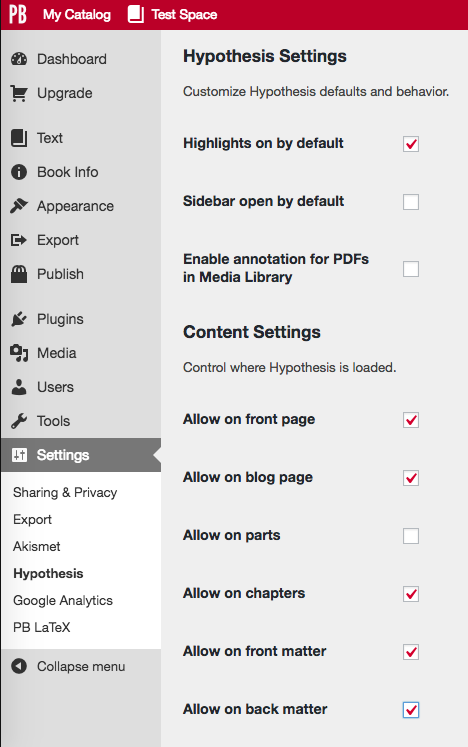
Including & Excluding Specific Chapters or Sections
Your Hypothesis settings also offer granular control over which chapters or sections have Hypothesis enabled. To employ this option, you will need the post ID for the chapter(s) or section(s) you wish to specify. To find this, when you are in the chapter editor, look in the address bar for post=[a number].
Once you have this number, you can enter it in the Hypothesis content settings in the appropriate field to allow or disallow Hypothesis on that specific page, overriding the global settings.
NOTE: If you’re entering more than one post ID, separate them with a comma only (no spaces!).
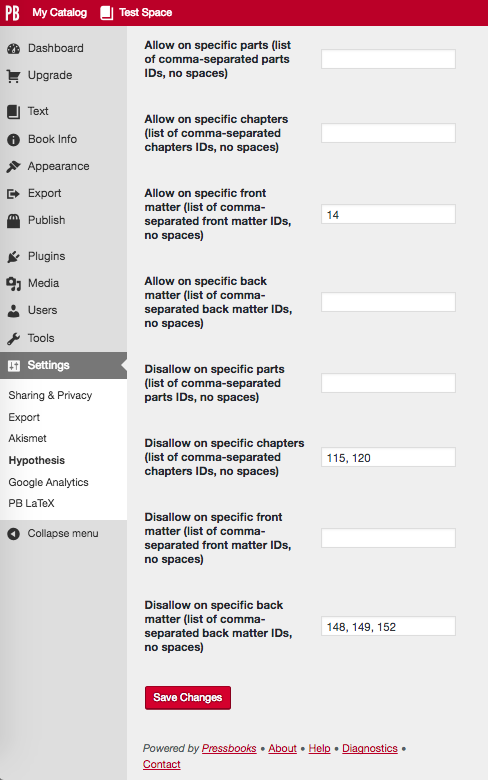
Uses
- Collaborative editing – users can set up a private group, leave comments and editing suggestions, and discuss changes right in the document.
- Reader feedback – if you’re sharing your book with early readers, they can offer feedback and comments, or you can leave the option open to anyone who is engaging with your books!
- Student engagement – students can be encouraged to engage with academic texts or books being discussed in class by leaving their thoughts and talking about the text among the class, offering those less likely to speak up in class the opportunity to share their thoughts.
Attributions
This chapter is an adaptation of, and is used under the noted license:
Getting Started with Pressbooks at TCC by TCC OER Librarian is licensed under a Creative Commons Attribution-NonCommercial-ShareAlike 4.0 International License, except where otherwise noted.

